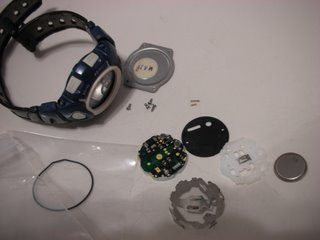Same type of deal goes for fixing things. When something breaks, I imagine I'm a kid in India and that thing is all I've got. If you gave an impovershed kid a perfect cell phone with a broken charger and a bike with broken gears, he'd already be pedalling his way up a dusty path on his new bike sad that nobody he knows has got a phone to call.
The other day, that Indian kid (me) got a water-damaged and 8-year-old watch that even Dicken would agree had no life about it. It was dead. I immediately took it apart and looked inside. There were indeed traces of water in there--it was dirty and kind of greasy, no condition for the inside of a watch.
I pried the movement away from the case and took a look. As I looked closer, I saw that there were actually individual parts to the movement, and that the battery cage had fingers which held the 3 main parts (the display / microchip, the microchip housing, and the plastic battery house *note, in the pics the display / microchip is never removed from the microchip housing*) together. I pried the cage off and the movevment fell apart. Oh, and a teeny tiny spring sprang. Oops.
I looked very closely at the microchip, and saw that there was greenish foamy corrosion between some of the contacts. I took the display off the microchip and saw the same thing at the corner of one of the connections. I held the movement with my left hand and gingerly removed the corrions with a knife in my right.
After putting the movement back together, (sans itty bitty spring) and popping in a new battery, it came to life.
Good news, except the backlight didn't work, and the water sealing issue hadn't been solved. I looked at a "change your Baby-G battery" tutorial online, and saw that the watch was missing a rubber O-ring. I called Casio and ordered the part (For $0.50 + $1.13 shipping!). It took two weeks to come.

I opened the package and got back to work.
There was still the problem of the escaped spring, and so I took the movement completely apart and started looking as closely as I could at all the contacts to see if they looked worn in anyway (aka they used to have a spring against them).

Finally I saw it! What a relief. The spring went through a seriously small hole and provided an electrical connection between the metal battery cage and the back of the microchip. This, I thought, must provide power to the backlight. I put the spring in the tiny hole and snapped the movement back together.

It worked!!!

Now I was getting really excited. I gave the inside of the case a thorough cleaning with Q-tips, which put tiny cotton fibers everywhere, so I had to spend a couple of minutes using tweezers to extricate them. I finally used a layer of lightly-Windexed paper towel over the edge of a knife to get rid of all the gunk.
Then I put the new o-ring in its place, cranked down on the caseback, and gave it a water test (in this picture you can see the other spring *from two pictures above* poking through the rubber movement backing).


And... The finished product:

I can't decide whether or not I'm surprised that it works, but I do know that I'm the proudest kid in India.

2 comments:
You rock, my friend. I thought I had ruined my wife's Baby G and couldn't find any manual anywhere...it was that little spring that nearly got me.
Did you order the o-ring at Casio website or at a Casio service center?
Post a Comment